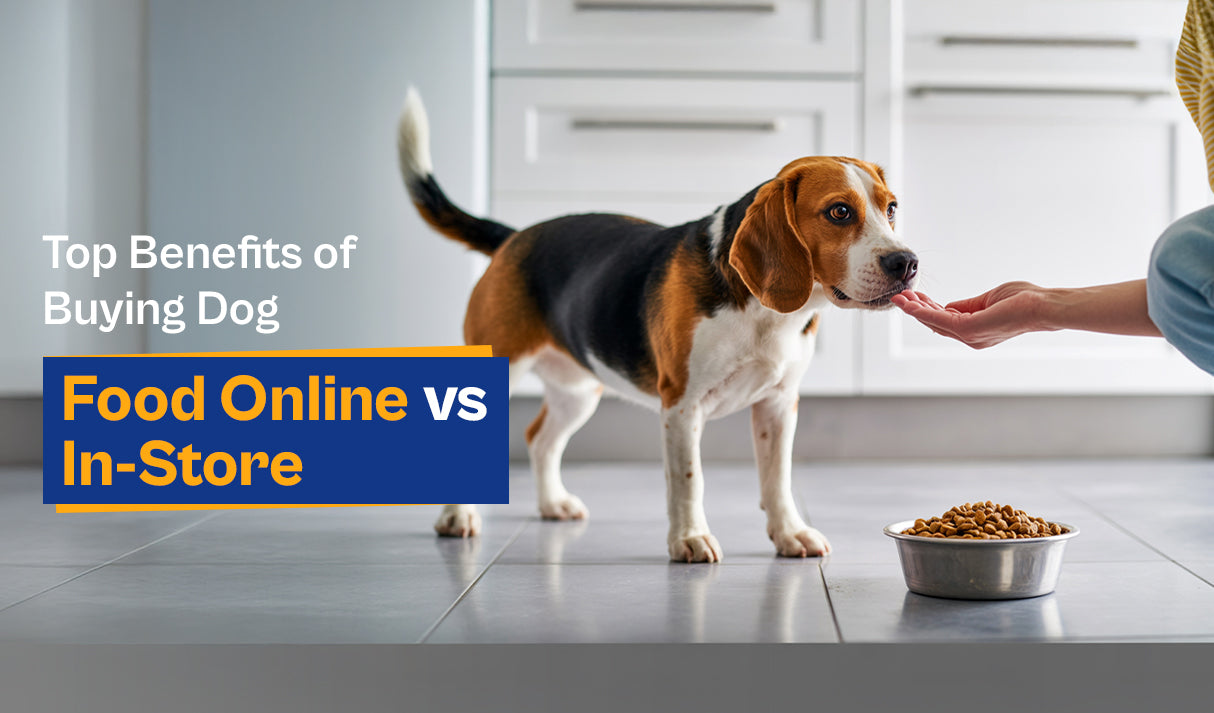Top 5 Tips to Choose Pet Food Online

I still remember the first time I sat down to buy dog food online for my beagle, Oscar. It was late, I was tired, and he had just turned up his nose at the expensive brand I picked from a local store. As I clicked through pages of shiny bags and big promises from every pet store online, I realised two things.
One, the internet doesn’t make choosing easier, it makes it louder. Two, if I wanted Oscar to stop side-eyeing his food bowl, I needed to get this right.
So, after years of trial and error (and yes, a few ruined carpets and suspicious stares from my dog), I’ve gathered what I think are the five most important things to keep in mind when buying pet food online.
1. Know What’s Really in the Bag (or the Tin)
Let’s be honest: pet food labels can be confusing. There’s a world of difference between “chicken-flavour” and “real chicken,” and once you notice that distinction, you can’t unsee it. The first step in choosing the right pet food online is learning how to read an ingredient list.
Look for:
-
A named protein as the first ingredient (chicken, lamb, salmon, not “meat by-product”).
-
Whole grains or vegetables for fibre (brown rice, sweet potatoes).
-
Avoid vague ingredients like “animal digest” or “artificial flavouring.”
Some top-tier brands go even further, offering detailed sourcing and preparation info. If your online pet shop isn’t transparent about ingredients, consider it a red flag.
2. Match the Food to Your Pet’s Age, Breed, and Lifestyle
Not all pets are built the same, and they don’t eat the same, either. That chunky Labrador? He needs something low-calorie but filling. A sprightly Shih Tzu puppy? Higher energy food, smaller kibble.
When browsing a pet store online, use filters based on:
-
Life Stage (Puppy, Adult, Senior)
Each stage of life comes with its own demands.
-
Puppies grow fast and need high-calorie, protein-rich food with calcium for strong bones and brain development.
-
Adults need maintenance diets that balance energy, weight control, and muscle health.
-
Seniors often require food that supports joint health, easy digestion, and immunity without excess calories.
Choosing age-appropriate food means your pet gets the right nutrients at the right time, nothing too much, nothing too little.
-
Breed Size
Tiny dog, tiny bites. Big dog, bigger energy needs.
-
Small breeds often prefer smaller kibble sizes and need calorie-dense food since their metabolism is quicker.
-
Large breeds benefit from food that supports joint strength, bone development, and weight management to prevent strain.
Some pet food online platforms allow you to filter by breed size, a real help when you’re shopping for a picky Pomeranian or a hungry Husky.
-
Activity Level
Your dog’s activity level is a big deal.
-
High-energy dogs (think Border Collies, Beagles) need more protein and fat to fuel their lifestyle.
-
Laid-back pups need portion control and lower-calorie diets to avoid unnecessary weight gain.
If your dog enjoys two naps before noon and prefers snuggling over sprinting, you might want to skip the ultra-high-energy formulas.
-
Any Known Allergies or Sensitivities
Digestive upsets, itchy skin, or ear infections may be tied to food intolerances.
-
Choose limited-ingredient diets or grain-free options for sensitive pets.
-
Look for clearly labelled protein sources, so if chicken doesn’t suit them, you can switch to lamb or fish.
The best online retailers let you search by these categories. If they don’t, you may find yourself squinting at blurry product images, trying to guess whether that bag of kibble is made for a Great Dane or a Dachshund.
3. Don’t Let Fancy Packaging Fool You, Check for Certifications and Reviews
Let me tell you, Oscar once guilt-tripped me into buying a bag of food with a picture of a golden retriever wearing sunglasses. The branding was cool, the reviews were minimal, and within two days, my cool purchase led to some very uncool tummy troubles.
To avoid this, always check for:
-
Certifications (AAFCO in the U.S., or other recognised standards in your country)
-
Honest, balanced reviews from real buyers
-
Return or satisfaction guarantees
A good online pets shop doesn’t just sell, it educates. The best ones have detailed descriptions, feeding guidelines, and even vet-written advice on pet nutrition.
4. Consider Fresh or Specialised Food Options
A growing number of pet parents are turning to fresh, lightly cooked, or specialised diets. Think of it like switching from microwave meals to home-cooked comfort food. For some pets, especially picky eaters or those with medical conditions, this can be a game changer.
These options are becoming more available across major platforms for pet food online, offering:
-
Customised meal plans based on your dog’s profile
-
Limited-ingredient or hypoallergenic options
-
Frozen or refrigerated delivery
Of course, convenience matters too. Check delivery timelines, subscription flexibility, and packaging (is it eco-friendly? Can you store it easily?).
5. Stick With Stores That Value Customer Experience, Not Just Cart Size
Customer service might not be the first thing you consider when shopping for dog food online, but when you’re managing your pet’s nutrition month after month, it matters.
Look for online pet stores that offer:
-
Responsive customer support (bonus if they have pet experts on hand)
-
Auto-ship or repeat delivery options (because running out of food at midnight is no fun)
-
Rewards programs or bulk purchase discounts
Some platforms even offer personalised food matching quizzes or first-order samples so your pet can try before you commit.
Final Thoughts (from a Pet Parent Who’s Been There)
Choosing pet food online isn’t about picking the fanciest brand or the cheapest deal. It’s about knowing your pet, understanding their needs, and being mindful of the small things that make a big difference. The right food can change everything, from energy levels and digestion to skin health and mood. (Oscar actually wags his tail now when dinner’s served, which wasn’t always the case.)
If you’re unsure where to start, look for stores like Hunger Tail. They don’t just sell pet food, they curate it. Their Adult Achiever – Chicken & Brown Rice kibble, for instance, isn’t just packed with high-quality protein and natural grains, it’s designed for adult dogs who need sustained energy and easy digestion. And the best part? It’s available across their seamless pet store online setup.
So, whether you’re upgrading from supermarket brands or just curious about healthier choices, take a little time to get it right. Your furry friend might not say thank you, but they’ll show it. In happy tail wags. In brighter eyes. And in fewer suspicious glances at the food bowl.



